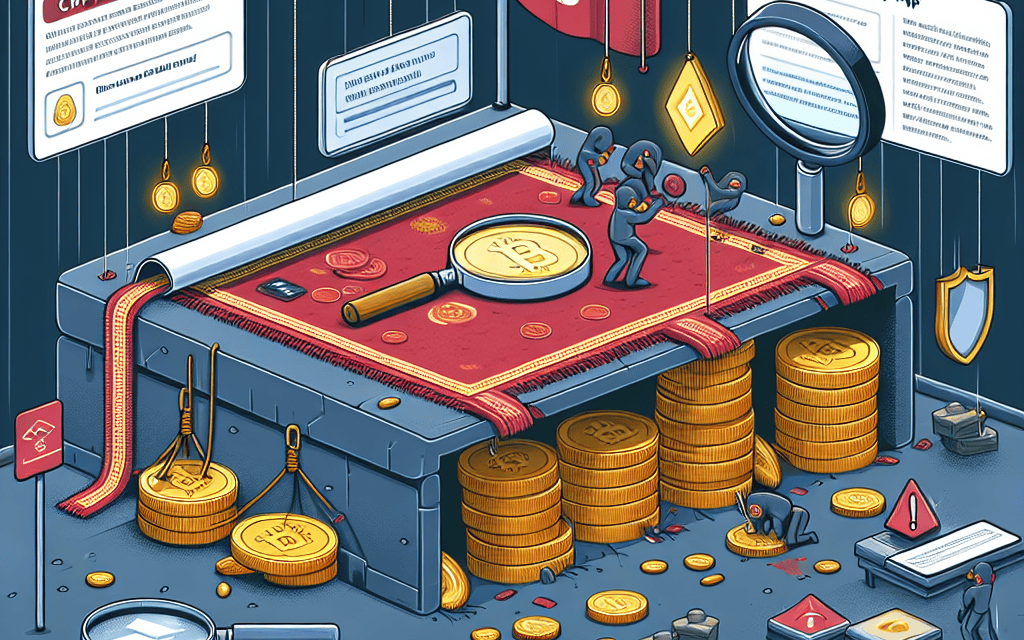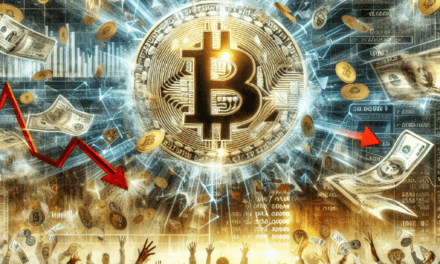“Unmask the Deception: Safeguard Your Investments from Crypto Rug Pulls”
Introduction
Crypto rug pulls have emerged as a significant threat in the rapidly evolving world of digital currencies, posing substantial risks to investors. These fraudulent schemes occur when developers of a cryptocurrency project suddenly withdraw all funds and abandon the project, leaving investors with worthless tokens. As the popularity of cryptocurrencies continues to rise, so does the sophistication of these scams, making it crucial for investors to be vigilant. Understanding how to identify potential rug pulls and implementing strategies to safeguard investments are essential steps for anyone participating in the crypto market. By recognizing red flags such as anonymous teams, lack of transparency, and unrealistic promises, investors can better protect themselves from falling victim to these deceptive practices. This guide aims to equip you with the knowledge and tools necessary to spot crypto rug pulls and secure your investments in this dynamic financial landscape.
Understanding Crypto Rug Pulls: A Beginner’s Guide
In the rapidly evolving world of cryptocurrency, the term “rug pull” has become increasingly prevalent, often serving as a cautionary tale for investors. A rug pull is a type of scam where developers abandon a project and run away with investors’ funds. This fraudulent act typically occurs in the decentralized finance (DeFi) space, where new tokens are launched with promises of high returns, only for the creators to disappear once they have amassed a significant amount of money. Understanding how to identify and protect oneself from such scams is crucial for anyone venturing into the crypto market.
To begin with, it is essential to recognize the common characteristics of a rug pull. These scams often involve newly launched tokens that are heavily promoted on social media platforms, promising extraordinary returns on investment. The developers may create a sense of urgency by claiming limited availability or time-sensitive opportunities, enticing investors to act quickly without conducting thorough research. Additionally, these projects may lack transparency, with anonymous or pseudonymous teams that provide little to no verifiable information about their identities or backgrounds.
One of the most effective ways to spot a potential rug pull is by examining the project’s liquidity. In legitimate projects, developers often lock liquidity in a smart contract for a specified period, ensuring that funds cannot be easily withdrawn. However, in a rug pull scenario, the liquidity is either not locked or locked for a very short duration, allowing the developers to remove it at any time. Investors should be wary of projects with unlocked liquidity or those that do not provide clear information about their liquidity lock status.
Another red flag to watch for is the distribution of tokens. In a rug pull, developers may hold a significant portion of the total token supply, giving them the power to manipulate the market by selling large amounts of tokens, causing the price to plummet. A fair distribution, where tokens are widely dispersed among a large number of holders, is generally a sign of a more trustworthy project. Investors should scrutinize the tokenomics and ensure that no single entity holds an overwhelming majority of the tokens.
Furthermore, the project’s code can offer insights into its legitimacy. Open-source projects that allow the community to review and audit the code are generally more reliable. Conversely, projects with closed-source code or those that do not undergo third-party audits may be hiding malicious intentions. Investors should seek out projects that prioritize transparency and have undergone rigorous security audits by reputable firms.
To protect oneself from rug pulls, due diligence is paramount. Investors should thoroughly research any project before committing funds, examining the team, whitepaper, roadmap, and community engagement. Engaging with the project’s community on platforms like Discord or Telegram can provide valuable insights into the project’s legitimacy and the developers’ intentions. Additionally, diversifying investments across multiple projects can mitigate the risk of significant losses from a single rug pull.
In conclusion, while the allure of high returns in the crypto market can be tempting, it is crucial to remain vigilant and informed. By understanding the warning signs of rug pulls and taking proactive measures to safeguard investments, individuals can navigate the crypto landscape with greater confidence and security. As the industry continues to grow and evolve, staying educated and cautious will be key to protecting one’s financial interests in the world of digital assets.
Key Red Flags of Potential Rug Pulls in Cryptocurrency
In the rapidly evolving world of cryptocurrency, the allure of high returns often attracts both seasoned investors and newcomers alike. However, this burgeoning market is not without its pitfalls, one of the most notorious being the “rug pull.” A rug pull occurs when developers of a cryptocurrency project suddenly withdraw all funds and disappear, leaving investors with worthless tokens. To safeguard your investments, it is crucial to recognize the key red flags that may indicate a potential rug pull.
Firstly, the anonymity of the development team should raise immediate concerns. While anonymity is not uncommon in the crypto space, projects with completely anonymous teams warrant a higher degree of scrutiny. Legitimate projects often have transparent teams with verifiable backgrounds. Therefore, if a project lacks information about its developers or if the team members cannot be found on professional networking sites, it may be wise to proceed with caution.
Another significant red flag is the absence of a clear and detailed whitepaper. A whitepaper serves as a blueprint for a cryptocurrency project, outlining its purpose, technology, and roadmap. Projects that fail to provide a comprehensive whitepaper or offer one that is vague and lacks substance should be approached with skepticism. A well-crafted whitepaper not only demonstrates the project’s legitimacy but also reflects the team’s commitment to transparency and accountability.
Moreover, the tokenomics of a project can offer valuable insights into its potential for a rug pull. Pay close attention to the distribution of tokens, particularly the allocation to the development team. If a significant portion of the tokens is held by the team, there is a heightened risk of them liquidating their holdings and abandoning the project. Additionally, projects with no lock-up periods for team-held tokens or those that allow for immediate and unrestricted selling should be scrutinized carefully.
Furthermore, the liquidity of a project is another critical factor to consider. Low liquidity can be a telltale sign of a potential rug pull, as it indicates that there are not enough funds to support the buying and selling of tokens. Projects that have locked liquidity or have partnered with reputable liquidity providers are generally more secure. Conversely, if the liquidity is controlled solely by the development team, it increases the risk of them withdrawing funds and executing a rug pull.
In addition to these financial indicators, the project’s online presence and community engagement can also serve as warning signs. Projects that lack active social media channels or have communities filled with bots and fake accounts should be viewed with suspicion. Genuine projects typically foster vibrant communities where developers engage with investors and provide regular updates. A lack of communication or evasive responses to inquiries can be indicative of a project with malicious intent.
Lastly, the promise of unrealistic returns is a classic red flag in the world of cryptocurrency. Projects that guarantee exorbitant profits with little to no risk are often too good to be true. While the crypto market is known for its volatility and potential for high returns, it is essential to approach such promises with a healthy dose of skepticism.
In conclusion, while the cryptocurrency market offers exciting opportunities, it is imperative to remain vigilant and conduct thorough due diligence before investing. By recognizing these key red flags, investors can better protect themselves from potential rug pulls and make informed decisions that safeguard their financial interests.
Analyzing Whitepapers: Spotting Deceptive Claims
In the rapidly evolving world of cryptocurrency, investors are often drawn to the allure of high returns and innovative projects. However, this burgeoning market is not without its pitfalls, one of the most notorious being the “rug pull.” A rug pull occurs when developers of a cryptocurrency project suddenly withdraw all funds, leaving investors with worthless tokens. To safeguard against such fraudulent schemes, it is crucial to scrutinize the project’s whitepaper, a document that outlines the technical and financial details of the cryptocurrency. Analyzing whitepapers with a critical eye can help investors identify deceptive claims and protect their investments.
To begin with, a comprehensive whitepaper should clearly articulate the problem the project aims to solve and how it intends to do so. If the whitepaper is vague or overly complex without justifiable reason, it may be a red flag. Projects that rely on buzzwords without providing a clear, logical explanation of their technology or business model should be approached with caution. Furthermore, the whitepaper should provide a detailed description of the project’s technology, including its architecture, consensus mechanism, and any unique features. If these elements are missing or inadequately explained, it could indicate that the project lacks substance or is attempting to mislead potential investors.
Moreover, the whitepaper should include a well-defined roadmap that outlines the project’s development timeline and milestones. A realistic and achievable roadmap demonstrates that the team has a clear plan for the project’s growth and sustainability. Conversely, an overly ambitious or vague roadmap may suggest that the project is more focused on generating hype than delivering results. Additionally, the whitepaper should disclose the project’s tokenomics, including the total supply of tokens, distribution plan, and any mechanisms for token burning or staking. Transparency in tokenomics is essential for assessing the project’s long-term viability and potential for value appreciation.
Another critical aspect to consider is the team behind the project. A credible whitepaper should provide information about the team’s members, their backgrounds, and their roles within the project. If the team is anonymous or lacks relevant experience, it may be a cause for concern. Investors should also verify the team’s credentials through independent research, such as checking their LinkedIn profiles or previous work in the industry. A strong, transparent team is often a good indicator of a project’s legitimacy and potential for success.
In addition to these elements, investors should be wary of whitepapers that make unrealistic promises or guarantee high returns with little to no risk. Such claims are often indicative of a scam, as legitimate projects will acknowledge the inherent risks and challenges associated with cryptocurrency investments. It is also advisable to cross-reference the whitepaper with other sources of information, such as the project’s website, social media channels, and community forums. Engaging with the community can provide valuable insights into the project’s credibility and the team’s responsiveness to investor concerns.
In conclusion, while the cryptocurrency market offers exciting opportunities, it is also fraught with risks, including the threat of rug pulls. By carefully analyzing whitepapers and being vigilant for deceptive claims, investors can better protect their investments and make informed decisions. A thorough examination of the project’s problem statement, technology, roadmap, tokenomics, and team can help identify potential red flags and ensure that investors are not swayed by empty promises or misleading information. Ultimately, due diligence and critical thinking are essential tools for navigating the complex landscape of cryptocurrency investments.
The Role of Social Media in Identifying Rug Pull Schemes

In the rapidly evolving world of cryptocurrency, the term “rug pull” has become synonymous with fraudulent schemes that leave investors in financial ruin. As digital currencies gain popularity, so too do the scams that exploit the unregulated nature of this market. One of the most effective tools for both identifying and preventing these schemes is social media. Platforms like Twitter, Reddit, and Telegram have become crucial in disseminating information and warnings about potential rug pulls. Understanding the role of social media in identifying these schemes is essential for any investor looking to protect their assets.
Social media serves as a double-edged sword in the cryptocurrency space. On one hand, it is a breeding ground for misinformation and hype, often used by scammers to lure unsuspecting investors into fraudulent projects. On the other hand, it is an invaluable resource for community-driven vigilance and education. The decentralized nature of social media allows for rapid information sharing, which can be both beneficial and detrimental. For instance, when a new cryptocurrency project is launched, it is often accompanied by a flurry of social media activity. Scammers exploit this by creating fake accounts and using bots to artificially inflate the perceived popularity of a project, thereby attracting more investors.
However, the same platforms that facilitate these scams also empower the community to fight back. Experienced investors and crypto enthusiasts often use social media to share insights and warnings about suspicious projects. By analyzing patterns in social media activity, such as sudden spikes in followers or engagement, one can often identify red flags indicative of a rug pull. Additionally, platforms like Twitter and Reddit host numerous forums and threads dedicated to discussing the legitimacy of new projects. These discussions can provide valuable insights and help investors make informed decisions.
Moreover, social media influencers play a significant role in shaping public perception of cryptocurrency projects. While some influencers are genuinely knowledgeable and provide valuable advice, others may be paid to promote fraudulent schemes. It is crucial for investors to critically evaluate the credibility of influencers and the projects they endorse. Cross-referencing information from multiple sources and seeking out independent reviews can help mitigate the risk of falling victim to a rug pull.
Furthermore, the transparency and immediacy of social media allow for real-time monitoring of a project’s development and community engagement. Investors can track the progress of a project by following its official channels and observing how the team interacts with its community. A lack of transparency, evasive communication, or sudden changes in project direction can be warning signs of a potential rug pull. Engaging with the community and asking critical questions can also provide insights into the project’s legitimacy.
In conclusion, while social media can be a breeding ground for cryptocurrency scams, it also serves as a powerful tool for identifying and preventing rug pulls. By leveraging the collective knowledge and vigilance of the crypto community, investors can better protect their investments. It is essential to remain skeptical, conduct thorough research, and utilize social media as a resource for gathering information and insights. As the cryptocurrency landscape continues to evolve, staying informed and vigilant will be key to navigating this complex and often treacherous market.
Due Diligence: Researching Crypto Projects and Teams
In the rapidly evolving world of cryptocurrency, the allure of high returns often attracts both seasoned investors and newcomers alike. However, this burgeoning market is not without its pitfalls, one of the most notorious being the “rug pull.” A rug pull occurs when developers of a cryptocurrency project suddenly withdraw all funds, leaving investors with worthless tokens. To safeguard your investments, it is crucial to conduct thorough due diligence when researching crypto projects and their teams.
To begin with, understanding the fundamentals of a project is essential. Start by examining the project’s whitepaper, which should clearly outline its objectives, technology, and roadmap. A well-crafted whitepaper demonstrates transparency and a solid foundation, whereas a vague or overly complex document may indicate potential red flags. Additionally, consider the project’s use case and whether it addresses a genuine market need. Projects with a clear, practical application are generally more reliable than those with ambiguous or speculative goals.
Transitioning to the team behind the project, it is imperative to scrutinize their credentials and experience. A reputable team will often have a public presence, with verifiable backgrounds in relevant fields such as blockchain technology, finance, or software development. LinkedIn profiles and previous work history can provide valuable insights into their expertise and credibility. Conversely, anonymous teams or those with limited information available should be approached with caution, as anonymity can sometimes be a cover for malicious intent.
Furthermore, community engagement is a vital aspect of any legitimate crypto project. Active communication channels, such as Telegram, Discord, or Twitter, can offer a glimpse into the project’s transparency and responsiveness. A project that regularly updates its community and addresses concerns openly is more likely to be trustworthy. In contrast, projects with inactive or heavily censored communication channels may be attempting to hide unfavorable information.
In addition to these factors, it is also beneficial to analyze the project’s tokenomics. This involves understanding the distribution of tokens, the total supply, and any mechanisms in place to prevent inflation or manipulation. Projects with a fair and transparent token distribution are generally more stable and less prone to sudden collapses. Moreover, be wary of projects that promise unrealistic returns or have a disproportionate allocation of tokens to the development team, as these can be indicators of a potential rug pull.
Another critical aspect to consider is the project’s audit status. Reputable projects often undergo third-party audits to ensure the security and integrity of their code. These audits can help identify vulnerabilities and provide an additional layer of assurance for investors. However, it is important to verify the credibility of the auditing firm, as not all audits are created equal.
Finally, while conducting due diligence, it is essential to remain vigilant and skeptical. The crypto space is rife with hype and speculation, and it is easy to be swayed by promises of quick profits. By maintaining a disciplined approach and thoroughly researching each project and its team, investors can significantly reduce the risk of falling victim to a rug pull.
In conclusion, protecting your investments in the cryptocurrency market requires a comprehensive understanding of the projects you choose to support. By carefully evaluating the project’s fundamentals, team, community engagement, tokenomics, and audit status, you can make informed decisions and safeguard your assets against potential scams. As the adage goes, “trust, but verify”—a principle that is particularly pertinent in the world of crypto investing.
Protecting Your Investments: Best Practices for Crypto Safety
In the rapidly evolving world of cryptocurrency, the allure of high returns often attracts both seasoned investors and newcomers alike. However, this burgeoning market is not without its pitfalls, one of the most notorious being the “rug pull.” A rug pull is a type of scam where developers abandon a project and run away with investors’ funds, leaving them with worthless tokens. As the crypto landscape continues to expand, understanding how to identify and protect oneself from such fraudulent schemes is crucial for safeguarding investments.
To begin with, it is essential to conduct thorough research before investing in any cryptocurrency project. This involves scrutinizing the project’s whitepaper, which should clearly outline the technology, use case, and roadmap. A well-documented whitepaper is often a sign of a legitimate project, whereas a vague or overly complex one may indicate potential red flags. Additionally, examining the team behind the project is vital. Legitimate projects typically have transparent teams with verifiable backgrounds and a history of involvement in reputable ventures. Conversely, anonymous or untraceable teams should be approached with caution.
Moreover, the liquidity of a cryptocurrency is another critical factor to consider. In a rug pull, developers often create a liquidity pool to facilitate trading, only to withdraw it later, leaving investors unable to sell their tokens. To mitigate this risk, investors should look for projects with locked liquidity, which means that the funds are secured in a smart contract for a predetermined period. This provides a level of assurance that the developers cannot easily abscond with the funds.
Furthermore, community engagement and sentiment can offer valuable insights into the legitimacy of a project. Active and transparent communication from the development team, coupled with a supportive and informed community, often indicates a healthy project. Social media platforms, forums, and dedicated channels can serve as useful resources for gauging community sentiment. However, it is important to remain vigilant for signs of artificial hype or shilling, which can be indicative of a pump-and-dump scheme.
In addition to these measures, employing technical tools can enhance an investor’s ability to detect potential rug pulls. Blockchain explorers and analytics platforms can provide data on token distribution and transaction history, revealing any suspicious activity such as large token holdings by a single entity or sudden spikes in trading volume. These tools can help investors make informed decisions based on empirical evidence rather than speculation.
While these strategies can significantly reduce the risk of falling victim to a rug pull, it is important to acknowledge that no investment is entirely without risk. Diversification remains a fundamental principle of investment strategy, and this holds true in the crypto space as well. By spreading investments across multiple projects and asset classes, investors can mitigate potential losses from any single venture.
In conclusion, the dynamic nature of the cryptocurrency market necessitates a proactive approach to investment safety. By conducting comprehensive research, assessing liquidity, engaging with the community, and utilizing technical tools, investors can better protect themselves from the threat of rug pulls. As the market continues to mature, staying informed and vigilant will remain key components of a successful investment strategy, ensuring that investors can navigate the crypto landscape with confidence and security.
Real-Life Examples of Rug Pulls and Lessons Learned
In the rapidly evolving world of cryptocurrency, the term “rug pull” has become synonymous with fraudulent schemes that leave investors in financial ruin. A rug pull occurs when developers of a cryptocurrency project suddenly withdraw all funds, leaving investors with worthless tokens. Understanding real-life examples of rug pulls can provide valuable insights into how these scams operate and how investors can protect themselves.
One of the most infamous rug pulls in recent history is the case of the Squid Game token, which capitalized on the popularity of the Netflix series. The token’s developers promised a play-to-earn game, attracting significant attention and investment. However, as the token’s value skyrocketed, the developers executed a rug pull, vanishing with an estimated $3.38 million. This incident highlighted the importance of conducting thorough research before investing in any cryptocurrency project. Investors should be wary of projects that lack transparency, have anonymous developers, or make unrealistic promises.
Another notable example is the case of the DeFi project, Meerkat Finance, which launched on the Binance Smart Chain. Shortly after its launch, the project reported a hack that resulted in the loss of $31 million. However, further investigation revealed that the so-called hack was an inside job orchestrated by the developers themselves. This incident underscores the necessity of scrutinizing the security measures and audit reports of any DeFi project. Investors should prioritize projects that have undergone rigorous third-party audits and have a clear track record of security.
The case of Compounder Finance further illustrates the deceptive tactics employed in rug pulls. The project initially gained trust by forking from a reputable DeFi protocol and undergoing a security audit. However, the developers inserted a malicious code that allowed them to drain funds from investors’ wallets. This example serves as a cautionary tale about the potential for even seemingly legitimate projects to harbor hidden risks. Investors should remain vigilant and continuously monitor project updates and community discussions for any signs of suspicious activity.
In addition to these examples, the case of Thodex, a Turkish cryptocurrency exchange, demonstrates how rug pulls can extend beyond DeFi projects to centralized platforms. Thodex abruptly halted trading and withdrawals, with its CEO fleeing the country with approximately $2 billion in investor funds. This incident highlights the importance of using reputable exchanges with a history of regulatory compliance and transparency. Investors should also consider diversifying their holdings across multiple platforms to mitigate the risk of losing all their assets in a single rug pull.
From these real-life examples, several lessons emerge that can help investors protect themselves from falling victim to rug pulls. First and foremost, conducting thorough due diligence is crucial. This includes researching the project’s team, examining the whitepaper, and assessing the project’s roadmap and community engagement. Additionally, investors should be cautious of projects that promise high returns with little risk, as these are often red flags for potential scams.
Furthermore, maintaining a healthy level of skepticism and staying informed about the latest developments in the cryptocurrency space can provide an added layer of protection. Engaging with online communities and forums can offer valuable insights and warnings about potential rug pulls. By learning from past incidents and remaining vigilant, investors can better navigate the complex and often treacherous landscape of cryptocurrency investments, safeguarding their assets from the threat of rug pulls.
Q&A
1. **What is a crypto rug pull?**
A crypto rug pull is a type of scam where developers of a cryptocurrency project suddenly withdraw all funds from the project’s liquidity pool, leaving investors with worthless tokens.
2. **How can you spot a potential rug pull?**
Look for red flags such as anonymous developers, lack of transparency, no clear roadmap, sudden hype without substance, and limited or locked liquidity.
3. **Why is liquidity important in identifying rug pulls?**
Low or locked liquidity can indicate that developers have control over the funds, making it easier for them to execute a rug pull.
4. **What role does the project’s whitepaper play in identifying rug pulls?**
A poorly written or vague whitepaper can be a warning sign, as it may indicate a lack of serious planning or intent to deliver on promises.
5. **How can social media activity help in spotting rug pulls?**
Excessive hype, fake endorsements, or aggressive marketing without substantial updates or developments can be indicative of a potential rug pull.
6. **What is the importance of community engagement in assessing a crypto project?**
A genuine project often has an active and engaged community, while a lack of community interaction or censorship of criticism can be a red flag.
7. **How can investors protect themselves from rug pulls?**
Conduct thorough research, diversify investments, use reputable exchanges, and be cautious of projects with unrealistic promises or anonymous teams.
Conclusion
Crypto rug pulls are a significant risk in the decentralized finance (DeFi) space, often resulting in substantial financial losses for investors. To spot potential rug pulls, investors should conduct thorough research, including examining the project’s whitepaper, team credibility, and community engagement. Red flags include anonymous developers, lack of transparency, unrealistic promises, and sudden changes in project direction. Additionally, investors should scrutinize the project’s code for vulnerabilities and ensure liquidity is locked. To protect investments, diversifying portfolios, using reputable exchanges, and staying informed about the latest security practices are crucial. By remaining vigilant and cautious, investors can mitigate the risks associated with crypto rug pulls and make more informed investment decisions.





